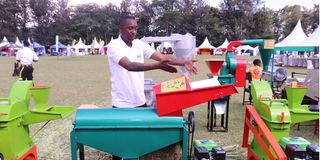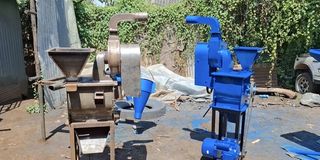Biz Lounge: Brains behind muthokoi-making machine

Stephen Ndung’u, a marketing expert and co-director of Hopeite Machinery explains the components of a maize sheller during the recent business expo at RiftValley Sports Club on May 30,2025.
For decades, maize farming has been at the heart of food production in Nakuru County, forming a core part of the region's food basket.
While much attention is often placed on planting and harvesting, the real and frequently invisible burden comes after the maize is off the stalk.
During drying, shelling, and grinding, a majority of women farmers bear the brunt of the labour, sometimes spending days over piles of maize, manually removing kernels, or walking long distances to access milling facilities.
It was this often-overlooked but exhausting part of the maize value chain that caught the attention of Elijah Mwangi, a professional engineer, and Stephen Ndung’u, a marketing expert.

Elijah Mwangi, an engineering professional and co-director of Hopeite Machinery, during an interview with Mtaa Wangu on June 5,2025.
The two innovators and co-directors of Hopeite Machinery saw an opportunity not only to ease this burden but to transform it into a source of empowerment and economic opportunity.
"Removing the outer skin of maize to make muthokoi or grade one flour was hard work," Mwangi says. "Women would mix the maize with ash and water, then boil it for several hours to soften it. Afterward, they had to rub it by hand to completely separate the maize from its skin."
Now, with just a switch, Mwangi says farmers can process three 90-kilogram bags of clean maize in just one hour. The bigger the machine, the more maize it can shell.
To use the machine, one places the maize into a feeding hopper, which directs the grain into the hulling chamber.
Inside this chamber, friction is created as the maize passes between the hulling blade and the hulling cylinder, effectively removing the outer skin of the maize.
What remains is the clean maize, commonly known as muthokoi, which can be consumed directly or ground to make grade-one flour.
The machine has two separate outlets: one for the maize and another for the maize germ. Once the clean grains are collected from one outlet, the maize germ is blown off through another outlet and can be ground into animal feed.

Fabricated maize hullers on display at the Hopeite yard at Kolen, Nakuru West sub-county, on June 5,2025.
The machine, which runs on electricity or a diesel engine, costs between Sh70,000 and Sh80,000, is portable, and has a cleaning efficiency of about 98 percent.
Similar to the maize huller is the maize sheller, which also improves farming efficiency.
The machine uses a shelling drum fitted with rotating beaters or teeth to separate kernels from the cobs. It runs on petrol, diesel, or electricity and includes a winnowing unit that blows away chaff and dust from the clean grain.
It has two outlets- one that collects the maize after it is separated from the cobs, and the other collects the empty cobs. The cobs can be chopped and mixed with other materials to make animal feed.
The sheller can process 20 to 90 kilogram bags of maize or sorghum per hour. Mwangi notes that this level of efficiency is incomparable to manual shelling, which typically costs around Sh300 per person in labour.
Winnowing can also be a challenge, as one person might take two hours to complete a single bag and may rely on wind availability.
He adds that hiring the machine is more cost-effective, as it only costs Sh120 per bag.
“To increase the speed of shelling, some farmers place the maize in a gunny bag and beat it until the kernels separate from the cobs. This method can lead to breakages of up to 30 percent, causing farmers to lose out on potential markets,” Mwangi notes.
The machine, which starts at Sh45,000, is portable, has a cleaning efficiency of about 98 percent, and maintains a breakage rate as low as 1 percent.
